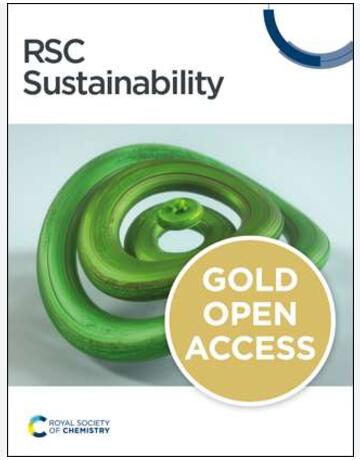Systematic LCA-AHP Approach to Compare Hydrometallurgical Routes for Copper Recovery from Printed Circuit Boards: Environmental Analysis
IF 3.3
3区 环境科学与生态学
Q2 ENVIRONMENTAL SCIENCES
引用次数: 0
Abstract
To ensure that metal recovery processes in electronic waste are truly sustainable from an industrial perspective, studies on the performance of such methodologies are necessary to verify the economic, environmental, social, and technological viabilities. The importance of conducting multicriteria and comparative investigations into the actual performances of methods used in the recovery of these materials is emphasized, considering trade-offs such as high efficiency in metal extraction balanced against intense consumption of energy and chemical reagents. The analytical hierarchy process, multicriteria decision support tool, and the life cycle assessment tool are proposed to be used in combination in this work to assess and contrast the environmental effects of two hydrometallurgical paths for the recuperation of copper in electronic circuit boards (PCBs). The results indicate that the sulfuric acid method had a copper solubilization efficiency of 90.05%, whereas the route employing the combination of ammonium sulfate and ammonia had an estimated copper solubilization efficacy of 49%. It was feasible to calculate the life cycle effects of the hydrometallurgical procedures connected to the copper recovery activities on the PCBs with regard to the LCA. Compared to the acidic leaching pathway, alkaline leaching was responsible for about 71% of the environmental damage discovered in the study, according to the AHP tool.系统化 LCA-AHP 方法比较从印刷电路板中回收铜的湿法冶金路线:环境分析
为确保从工业角度看电子废物中的金属回收过程真正具有可持续性,有必要对这些方法的性能进行研究,以验证其经济、环境、社会和技术可行性。考虑到金属提取的高效率与能源和化学试剂的高消耗之间的权衡,强调了对用于回收这些材料的方法的实际性能进行多标准比较研究的重要性。在这项工作中,建议结合使用层次分析法、多标准决策支持工具和生命周期评估工具,以评估和对比用于回收电子线路板(PCB)中铜的两种湿法冶金途径对环境的影响。结果表明,硫酸法的铜溶解效率为 90.05%,而采用硫酸铵和氨组合的途径的铜溶解效率估计为 49%。就生命周期评估而言,计算与铜回收活动有关的湿法冶金程序对多氯联苯的生命周期影响是可行的。根据 AHP 工具,与酸性浸出途径相比,碱性浸出对研究中发现的约 71% 的环境破坏负有责任。
本文章由计算机程序翻译,如有差异,请以英文原文为准。
求助全文
约1分钟内获得全文
求助全文
来源期刊

Sustainability
ENVIRONMENTAL SCIENCES-ENVIRONMENTAL SCIENCES
CiteScore
6.80
自引率
20.50%
发文量
14120
审稿时长
17.72 days
期刊介绍:
Sustainability (ISSN 2071-1050) is an international and cross-disciplinary scholarly, open access journal of environmental, cultural, economic and social sustainability of human beings, which provides an advanced forum for studies related to sustainability and sustainable development. It publishes reviews, regular research papers, communications and short notes, and there is no restriction on the length of the papers. Our aim is to encourage scientists to publish their experimental and theoretical research relating to natural sciences, social sciences and humanities in as much detail as possible in order to promote scientific predictions and impact assessments of global change and development. Full experimental and methodical details must be provided so that the results can be reproduced.
 求助内容:
求助内容: 应助结果提醒方式:
应助结果提醒方式:


